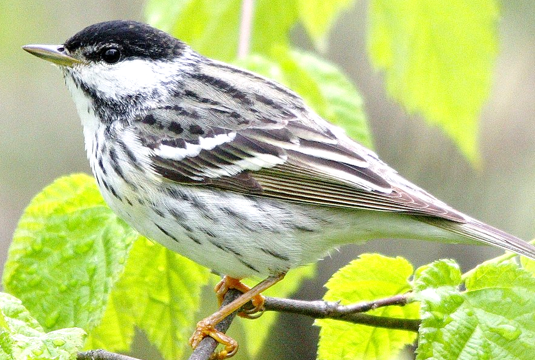Ken Baker: Migration dangers may be cause of Blackpoll Warblers' decline

With a population estimated around 60 million birds, the Blackpoll Warbler is one of the most abundant of North America’s 54 species of New World Warblers. And since it breeds away from most human habitation, in the boreal (northern) coniferous forests stretching from Quebec to Alaska, you might expect its numbers have been relatively stable in recent years.
That does not appear to be the case.
In 2019, a team of researchers, led by renowned Cornell ornithologist Kenneth Rosenberg, published a study based on an array of long-term surveys of 529 species of birds breeding in the U.S. and Canada. Their disquieting results indicated a net loss of 2.9 billion birds between 1970 and 2018 — a reduction amounting to 29% of the continent’s total population of breeding birds during that 48-year period.
Abundant as the Blackpoll may currently be, it was nonetheless shown to be one of the species in steepest decline, having experienced an astonishing 95% drop in abundance since 1970. Although scientists do not fully understand all the reasons for such a precipitous decline, it’s likely that dangers it faces during its annual migration to and from overwintering grounds in South America play a significant role.
Migratory species face steepest declines
In fact, the Rosenberg study found that the lion’s share (86%) of that 2.9 billion decline in North America’s avifauna was experienced by the study’s 419 migratory species, while the 100 resident (nonmigratory) species investigated actually experienced a small net increase in numbers (26 million) since 1970.
Whatever the advantages that favored the initial evolution of migratory behavior in birds millions of years ago, the rules of the game have clearly changed over the past two hundred or so years as humans’ impact on the world’s ecosystems has become ever more pervasive.
A useful approximation is that a gram weighs about the same as one paperclip. So a 12-gram Blackpoll Warbler foraging on its territory in, say, western Yukon in mid-July, would have the weight of about 12 paperclips.
But that same bird could well weigh in at 32 paperclips in early October. And it won’t be found in a western Canadian tamarack bog but in a woodlot somewhere along the eastern coast of Virginia. Hold the bird on its back in your hand and lightly blow at the feathers over its belly. They’ll part to reveal bulging masses of white fat just under the warbler’s transparent skin.
The Blackpoll will need those bulked up fat reserves because, after having flown 3,200 miles across North America, its migration has only just begun. With a tailwind coming out of the northwest, the Blackpoll now takes off on the longest, nonstop transoceanic flight of any songbird — 60 to 70 hours to cover 1,400 to 2,100 miles to South America.

Intriguingly, the birds appear to fly with a southeast bearing for the entire trip over the Atlantic which would take them well east of their overwintering area but for trade-winds coming out of the northeast that blow them southwest to their overwintering grounds in northern Colombia, Venezuela or Brazil.
Here’s the interesting bit. The straight-line distance from, say, western Yukon to eastern Colombia, is about 3,000 miles. But our Yukon Blackpoll didn’t take that path. Instead, it first headed east across North America and then out over the open ocean for a total trip of some 5,000 miles. Why take the long route?
Because that’s the way Blackpoll Warbler migration evolved. And because, until quite recently, it did the job. That is to say, their curious, energetically expensive migratory route has allowed countless generations of migrants to survive and reproduce successfully … at least until now.
Climate change, fewer insects affect bird populations
With increasing rates of human-caused degradation of their overwintering and en route rest stop habitats, climate change induced warming of their northern breeding areas, and the precipitous depletion of the insect populations on which they feed, the long-term outlook for the species is not promising.
But how did the Blackpoll’s — or any species’ — migratory pattern evolve in the first place?
Recent genetic analyses of evolutionary relationships among avian species have shown that birds have been migrating, to a lesser or greater degree, since there have been birds. Furthermore, migratory behavior has developed, ceased, and developed again within most lineages (sequences of related species) as environmental conditions have changed.
In the case of the Blackpoll and many other northern birds, it's useful to remember that over the last 2.5 million years there have been more than 20 cycles of advancing and retreating sheets of glacial ice, each one driving northern forests, grasslands, and their inhabitants southward on advancing and allowing them back north when retreating.
There’s evidence to suggest that during interglacial periods (such as the current one we entered about 15,000 years ago) the Blackpoll extended its breeding range westward from the northeastern corner of the continent as the glacial sheet withdrew.
And now, each year as winter approaches, individual Blackpolls retrace those range expansions — first back east and then south — as a migratory route that had become ingrained in their genetic makeup over thousands of years of adaptation to seasonal shifts in resource availability.
Ken Baker is a retired professor of biology and environmental studies. If you have a natural history topic you would like Dr. Baker to consider for an upcoming column, please email your idea to fre-newsdesk@gannett.com.
This article originally appeared on Fremont News-Messenger: Migration dangers may be cause of Blackpoll Warblers' decline

